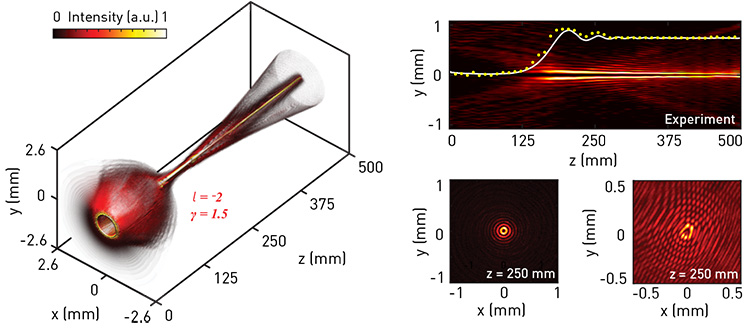 Left: Illustration of pin-like optical vortex beam (POVB) dynamics by comparing a vortex pin and a normally diffracted vortex beam. Right: Demonstrations showing the side-view intensity of POVB propagation in the y-z plane, with a phase modulation parameter γ = 1.5 and a topological charge l = -2. Experimental peak-intensity values (yellow dots) at each distance z are overlapped onto the predicted curve (solid white line). The transverse intensity distribution and interferogram of the POVB were recorded at z = 250 mm.
Left: Illustration of pin-like optical vortex beam (POVB) dynamics by comparing a vortex pin and a normally diffracted vortex beam. Right: Demonstrations showing the side-view intensity of POVB propagation in the y-z plane, with a phase modulation parameter γ = 1.5 and a topological charge l = -2. Experimental peak-intensity values (yellow dots) at each distance z are overlapped onto the predicted curve (solid white line). The transverse intensity distribution and interferogram of the POVB were recorded at z = 250 mm.
Optical vortex beams have attracted great attention for their peculiar characteristics due to a topological-phase singularity associated with orbital angular momentum (OAM) and donut-shaped intensity distribution. These have laid the basis for fundamental research and applications in optics and photonics.1 Key challenges for exploiting vortex beams include engineering their properties and limiting or suppressing the adverse diffraction effects.
In previous work, we introduced a new type of anti-diffracting structured light—an optical pin-like beam (OPB) that exhibits a highly localized pin-like intensity distribution over kilometer-scale distances while traversing through atmospheric turbulence.2,3 Recently, we have extended the OPB concept and scheme to optical OAM-carrying beams, demonstrating, both theoretically and experimentally, pin-like optical vortex beams (POVBs).4,5 This work brings about new perspectives for the generation of robust yet controllable optical vortex beams with extraordinary features for advanced applications.
We found that the dynamic propagation of POVBs involves an initial autofocusing stage before the maximum intensity is reached, followed by a reshaping stage where the beam turns into a high-order vortex Bessel-like pattern. During subsequent propagation, the annular main lobe width and the hollow-core radius of the POVBs remain nearly invariant, with a certain degree of tunability.
From a physical viewpoint, the POVBs are generated by modulating both the phase and the amplitude profiles of an initial monochromatic plane wave in real space. The phase structure is obtained by superimposing a radially symmetric power-law phase on a helical phase structure, embedding an OAM term with an arbitrary topological charge. The amplitude structure is appropriately engineered to control the peak intensity evolution over the propagation range and increases the anti-diffracting features.
Experimentally, we realized POVBs by modulating the phase of an input laser beam via spatial light modulator-based shaping techniques, so as to encode both amplitude and phase. Our experimental results are in excellent agreement with theoretical predictions.4,5
This work expands our understanding of pin-like anti-diffracting optical vortex beams and builds a connection between singular optics and structured light for long-distance free-space optics. Applications could be found in different areas such as optical communication and quantum information technologies, as well as optical manipulation in which POVBs may create optical forces for trapping and controlling particles or cells.
Researchers
D. Bongiovanni, Nankai University, Tianjin, China, and Institut National de la Recherche Scientifique (INRS-EMT), Varennes, Canada
R. Morandotti, INRS-EMT, Varennes, Canada
Y. Hu, D. Song and Z. Chen, Nankai University, Tianjin, China
D. Li, Research Institute of Chemical Defense, Beijing, China
M. Goutsoulas and N.K. Efremidis, University of Crete, Heraklion, Greece
Z. Zhang, Chinese Academy of Sciences, Beijing, China
References
1. Y. Shen et al. Light Sci. App. 8, 90 (2019).
2. Z. Zhang et al. APL Photon. 4, 076103 (2019).
3. D. Li et al. OSA Continuum 3, 1525 (2020).
4. M. Goutsoulas et al. Opt. Lett. 45, 1830 (2020).
5. D. Bongiovanni et al. Photon. Res. 9, 1204 (2021).
